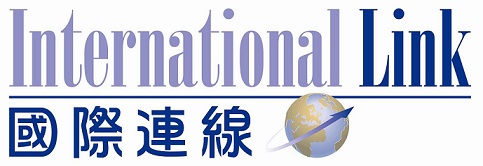菲律賓與香港關係 Philippines-Hong Kong
菲律賓與香港關係
Philippines-Hong Kong Special Administrative Region Relations
The Government of the Republic of the Philippines enjoys cordial relations with the Government of Hong Kong Special Administrative Region. This relationship is founded on deep historical ties, dynamic people-to-people links, and solid economic relations.
In 2013, Hong Kong ranked 7th as the Philippines’ top trading partner. Bilateral trade between the Philippines and Hong Kong accounted for US$5.84 billion (4.90% of the Philippines’ total external trade). On the other hand, Hong Kong ranked as the Philippines’ 13th largest supplier of imports. Top Philippine exports to Hong Kong in 2013 consisted of electronic micro-assemblies, digital monolithic integrated circuits, computer storage units and other digital monolithic integrated circuits and semi-conductor devices. Major imports consisted of transmission apparatus; materials, accessories and supplies imported on consignment basis for the manufacture of electrical and electronic machinery; materials, accessories and supplies imported on consignment basis for the manufacture of frames; parts and accessories of automatic data processing machines; and other materials, accessories and supplies imported on consignment basis for the manufacture of semiconductor devices. (Department of Trade & Industry-Export Management Bureau (DTI-EMB), “PH-HK Trade Relations” as of 29October 2014)
The Filipino community, around 190,000 nationals, is a huge boost to Hong Kong’s lively cultural mix. Filipinos working in Hong Kong are engaged in various fields from hotel and household staff to bankers, managers, architects, engineers, journalists, teachers, office workers, musicians and entertainers to shop keepers.
In 2013, Hong Kong was the Philippines’ 17th source of foreign investments (FI) with US$13.77 million worth of approved investments. The bulk of approved FI from Hong Kong was intended to fund manufacturing projects with investments valued at US$7.76 million and administrative and support service activities worth US$3.23 million. (Ibid)
In terms of Foreign Direct Investments (FDI) received in comparison to ASEAN neighbors, the Philippines received US$2.797 billion FDI in 2012, ranking 6th. Hong Kong’s FDIs to ASEAN are as follows: Singapore, US$56.651 billion; Indonesia, US$19.853 billion; Malaysia, US$10.074 billion; Thailand, US$8.607 billion; and Vietnam, US$8.368 billion. (Accessed on 13 November 2014)
According to the Hong Kong Census and Statistics Department, 36 Philippine companies had set up their local offices in Hong Kong as of June 2012. Most of these companies are engaged in banking and finance, insurance, remittances, telecommunications, airlines, logistics, law firms and food industries.
The Consulate General of the Philippines continues to push for the strengthening of Philippines-Hong Kong relations in all fronts such as tourism, people-to-people exchanges, culture (especially under the auspices of the Philippines-China Years of Friendly Exchanges), and trade and investment.
--------------------------------------------------------------------
Economic Situation
Philippine economic growth accelerated to 7.2% in 2013 despite the impact of Typhoon Haiyan (Yolanda) and other natural disasters during the year. The country’s strong macroeconomic fundamentals supported domestic demand and shielded the economy from the lingering weakness of the global economy.
Robust performance of consumption fueled by strong remittances and services, supported by investment and manufacturing expansion, boosted growth. Private consumption grew by 5.6%, while private construction also grew by 8% due to low interest rates and the strong demand for office and residential spaces by workers in the business process outsourcing industry. Confidence in the domestic economy remained high and was recognized with a third credit rating upgrade to investment grade.
Monetary and fiscal policy remained supportive of growth. With CPI inflation easing to 3 percent in 2013, policy rates stayed at low levels of 3.5% and 5.5% for the overnight borrowing and lending rates, respectively. Government finances continued to improve with better tax administration and efficient spending. Revenue collection grew by about 12%.
The following are 10 indicators of a growing Philippine economy:
(Board of Investments-International Investments Promotion Service, “Investments Briefing” as of 14 October 2014.)
1. Stable and Resilient Economic Growth
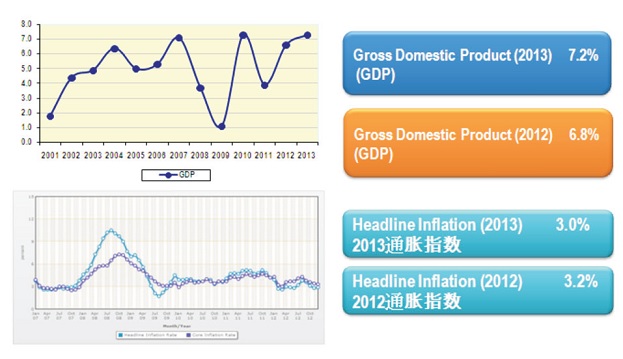
Source: National Statistical Coordination Board
2. Continuous Inflow of Overseas Filipino Workers (OFW) Remittances
• 2014 Q1: US$6.08 Billion (6.6%) increase
2013 Q1: US$5.71 Billion
• 2013: US$22.76 Billion (6.4% increase)
2012: US$21.39 Billion
Remittance drew strength from demand for skilled and professional Filipinos abroad, along with better data capture through banks and financial institutions.
3. Steady Export Growth
• Merchandise Exports:
2013: US$54 Billion (3.6% higher than in 2012)
2012: US$51.99 Billion
• Service Exports:
2013: US$21.8 Billion
(anchored on Business Processing Management (BPM) sector that generated revenues of US$15.5 Billion and direct employment of 900,000)
2012: US$20.4 Billion
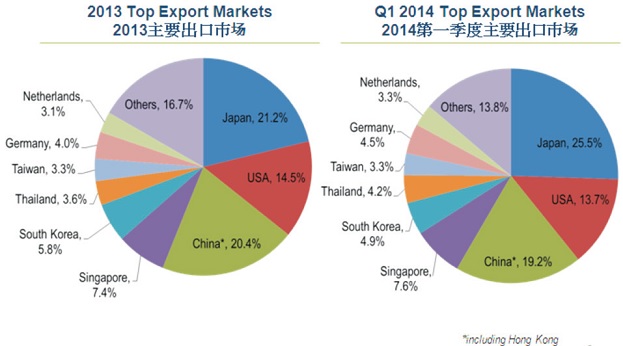
4. Steady Investment Flows
• Total Investments:
2013: US$17.48 Billion
2012: US$15.92 Billion
• Total Foreign Investments
2013: US$6.31 Billion
2012: US$6.69 Billion

China ranked as the Philippine’s14th top source of investment in 2013. The Philippines received US$29.24 million in Chinese investments in 2013, which represented approximately 0.5% of investments into the special zones under various Investment Promotion Agencies (IPA). From 2011 to 2013, 64% of the Chinese investments to the Philippines went into the manufacturing industry and 16% in the mining and quarrying industry.
China committed US$201.54 Million or 24.2% share of the total IPA-approved investments in the first quarter of 2014, making it the top performing country. It was 7,050.6% higher than the recorded investment pledges from China during the same period in 2013.
5. Robust Domestic Financial Sector Coupled with Credit Growth

6. Efficient Revenue Collection
• National Government Revenues
Jan-Nov 2013: Php 1.565 Trillion
2012 :Php 1.534 Trillion
• National Government Fiscal Deficit
Jan-Nov 2013: Php 111.5 Billion
2012 : Php242.827 Billion
7. Improving Global Competitiveness Ranking
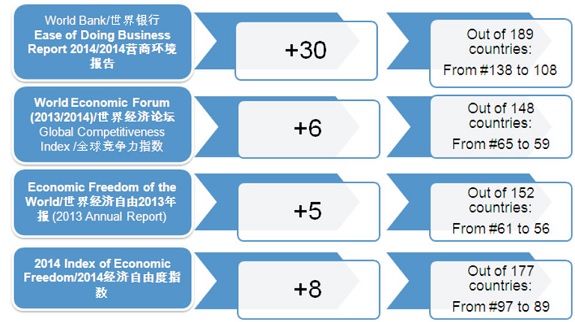
8. Dynamic People
• The Philippines is one of the new emerging countries due to favorable demographics and strong economic fundamentals.
• The Philippines has the 12th largest population in the world.
• The HSBC World Explorer Survey 2011 ranked the Philippines as “Asia’s friendliest country” and “8th World’s friendliest country”.
• According to the HSBC’s “The World in 2050” Report, it is set to become the worlds 16th largest economy, up 27 places from today.
9. Strenghtened Governance and Anti-Corruption Measures
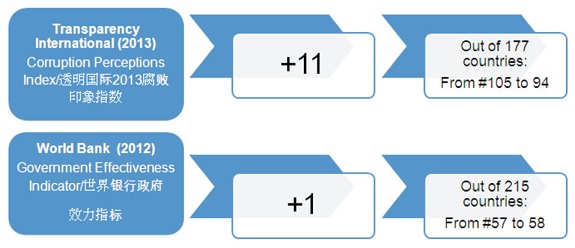
10. Credit Ratings
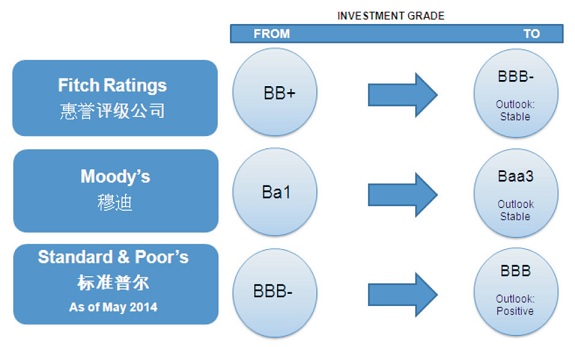
--------------------------------------------------------------------
Tourism Sector
Always a fun destination that value tourists’ safety and well-being, the Philippines continues to receive visitors thru its international and domestic transport system. With a great majority of touristic offerings, whether one is looking for natural wonders, historical landmarks, culture and tradition, arts & crafts, shopping, recreation and entertainment, the Philippines has it all. Tourism activities thrive and increase in the country’s different regions, each with their own unique destinations and products.
For the period January-August 2014, there were 783,852 visitors from South Korea (23.99%), 308, 393 from China (9.44%), 310,901 visitors from Japan and Hong Kong contributing 75,777 tourists (DOT, 2014). (Inputs from DOT sent by ASPAC for the One Asia interview)
According to the 2013 Visitor Sample Survey (VSS) of the Philippines Department of Tourism (DOT), the top three most liked about their visit are:
1. warm hospitality and kindness of the people,
2. beautiful sceneries/ nice beaches,
3. good food, liquor and fruits.
The country’s 7,107 islands double as the stage on which Filipinos can best present themselves while being the best tourist agents for the place. With their ability to ‘turn strangers into friends, sights to memories, and adventures into unforgettable experiences,’ the Filipinos are the driving force that makes the Philippines a favourite destination for many.
Fast becoming a preferred Philippine tourist destination is Palawan, “with its majestic limestone cliffs, wondrous underwater scenes, breath-taking beaches and eco-luxury resorts.” Named “World’s Best Island” in 2013 and 2014, it also gained international fame when its Puerto Princesa Subterranean River, said to be the longest navigable underground river in the world, was recognized as one of the New Seven Wonders of Nature in 2012. Moreover, the United Nations Educational, Scientific and Cultural Organization (UNESCO) declared the river a World Heritage Site in 1999.
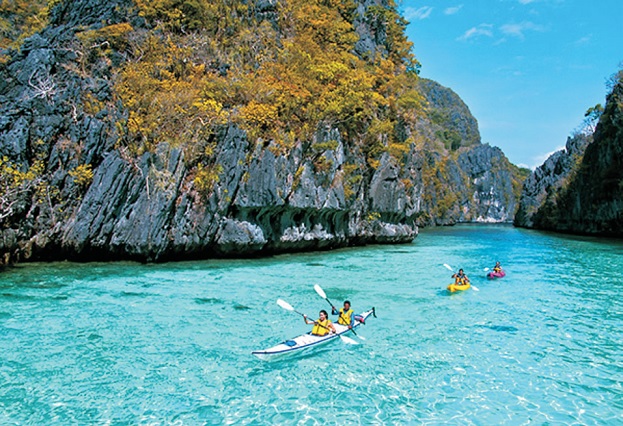
Palawan is the world’s top island (Conde Nast Traveler).
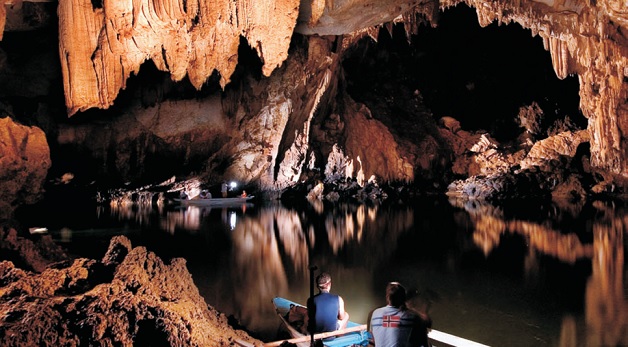
A tour of the Puerto Princesa Underground River, a UNESCO World Heritage Site and one of the “New 7 Wonders of Nature” , should be at the top of your to-do list in this part of the archipelago (http://itsmorefuninthephilippines.com/puerto-princesa-underground-river).
Another island consistently cited by international travel publications as one of the world’s best beaches is Boracay. It serves as a perfect go-to destination for water sports activities, enjoyment, and relaxation. Aside from its white sand beaches, Boracay’s thriving nightlife regularly draws tourists, both local and foreign.
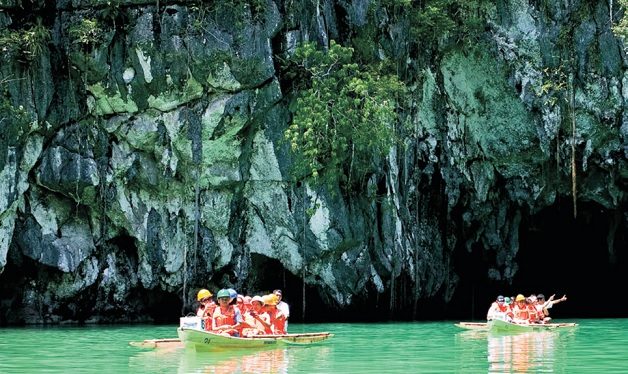
The campaign ‘It’s more fun in the Philippines’ fulfills its objective of making the Philippines the most talked about, shared and searched-for tourism slogan in South East Asia.
In line with this, the DOT, together with its marketing and promotions arm the Tourism Promotions Board (TPB) launched its new campaign “Visit the Philippines Year 2015” (VPY 2015). Sustaining the former campaign, VPY 2015 is also meant to revitalize and augment ‘It’s More Fun in the Philippines.’
The VPY 2015 campaign emphasizes five main themes:
1.) Business,
2.) Music, Arts and Entertainment
3.) Lifestyle
4.) History and Culture,
5.) Sports, Adventure and Ecotourism events.
For more details, please go to : http://tpb.gov.ph/
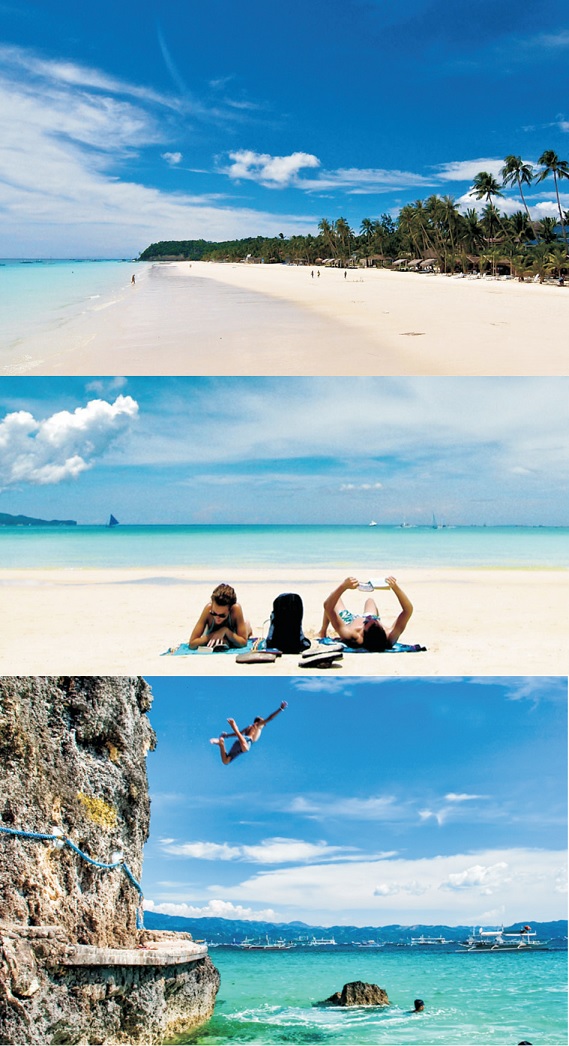
Boracay is a tropical island surrounded by pristine white sand beaches (www.itsmorefuninthephilippines.com/boracay).
--------------------------------------------------------------------
Philippine’s Culture
Philippine Consulate General in Hong Kong conducts Lecture Series on Philippine Culture and Preserving the Philippines’ Cultural Heritage, September 2014
The Philippine Consulate General in Hong Kong conducted a two-part Lecture Series on Philippine culture and heritage in September 2014 featuring Chairman Felipe De Leon, Jr. of the National Commission for Culture and the Arts (NCCA), and Mr. Ivan Henares, President of the Heritage
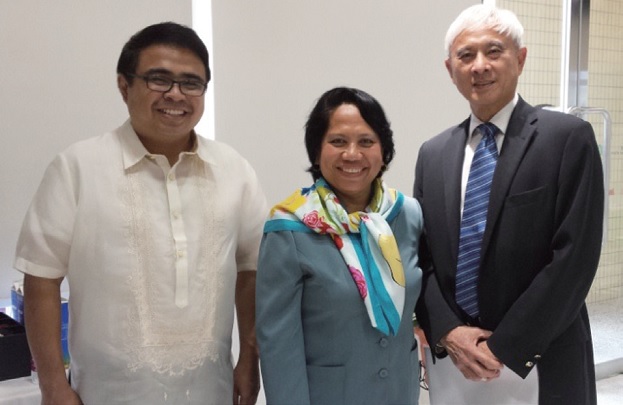
Mr. Ivan Henares, Consul General Bernardita L. Catalla and Professor Frank Fu during the lecture at Hong Kong Baptist University (HKBU). (from L to R)
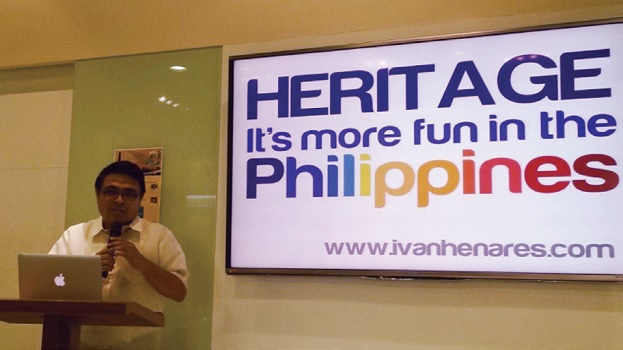
Mr. Henares lecturing on Philippine heritage conservation initiatives at HKBU.
Conservation Society of the Philippines.
Mr. Ivan Henares’ lecture titled “Preserving the Philippines' Cultural Heritage: Milestones and Challenges: A Lecture on the Philippines' Cultural Heritage Conservation Initiatives and Discussion on Post-Bohol Earthquake and Post-Haiyan Restoration Efforts” was held at the following venues:
• iCafe Activities Room, Hong Kong Baptist University, 18 September. The lecture was the first-ever lecture to be held at the said venue;
• Delia Memorial School (Hip Wo Campus), 19 September. Mr. Henares presented his lecture to around 260 secondary school students of various nationalities; and
• Hong Kong Visual Arts Centre Theatre, 19 September. The event was attended by the diplomatic corps, as well as representatives from the Filipino Community, media, academe and civil society.

Mr. Henares (left) during the question and answer portion of his lecture at Delia Memorial School (Hip Wo Campus).
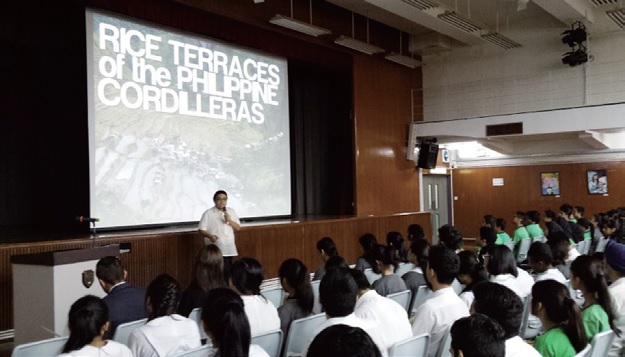
Mr. Henares lecturing on preserving the Rice Terraces of the Cordilleras at Delia Memorial School (Hip Wo Campus).
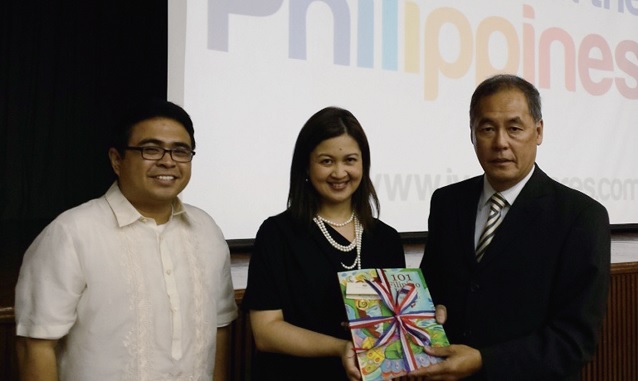
Mr. Henares and Deputy Consul General Rosanna Villamor Voogel presenting the 101 Filipino Icons book souvenir to Delia Memorial School Principal, Mr. Tsui Fook Keung.
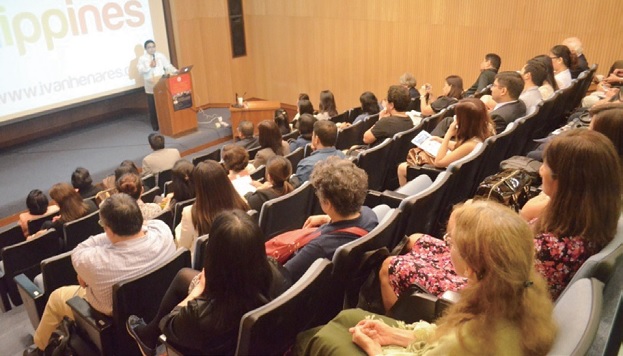
Mr. Henares during his lecture at the Hong Kong Visual Arts Centre Theatre.

Banner promoting Mr. Henares’ lecture at the Hong Kong Visual Arts Centre Theatre.
Chairman Felipe De Leon, Jr.’s lecture on the other hand was titled “A Heritage of Well-Being: Connectivity of the Filipino”. He emphasized that Filipino ethnicity is essentially rooted on the culture of communal sharing.
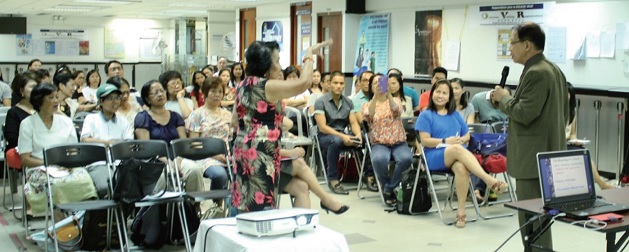
Chairman Felipe De Leon, Jr. during his interactive lecture for the Filipino Community at the Consulate’s Public Area.
Chairman De Leon conducted lectures at the following venues:
• Lecture for the Filipino Community at the Philippine Consulate General Public Area, 21 September;
• Hong Kong Taoist Association Wun Tsuen School, 22 September. Around 200 primary school students from different ethnic backgrounds attended the lecture, and Chairman De Leon donated books on the Philippines courtesy of NCCA to the school’s Multicultural Department; and
• iCafe Activities Room, Hong Kong Baptist University (HKBU), 23 September. Chairman De Leon also met with Professor Johnny Poon, Head of HKBU’s Music Department.
Chairman De Leon also participated as panelist in the Asia Society panel discussion, “Road to Recovery: Philippines Ten Months after Haiyan”, on 21 September. Philippine Red Cross Secretary General Gwendolyn Pang was also a panelist at the event. The discussion focused on the progress of the rehabilitation efforts, as well as the issues and challenges of the Philippine Government, international organizations and non-government organizations in implementing programs to assist the areas affected by the typhoon.
The two-part lecture series is an initiative under the auspices of Philippines-Hong Kong Memorandum of Understanding on Cultural Cooperation signed on 14 February 2003. This landmark document aims to promote cultural exchanges especially on arts and education.
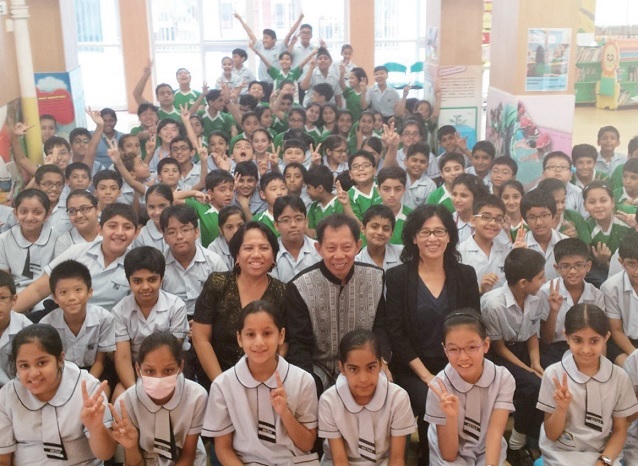
Consul General Catalla, Chairman De Leon and Principal Lau Wai Chun (from L to R) of the Hong Kong Taoist Association School with the primary school students who attended the lecture.
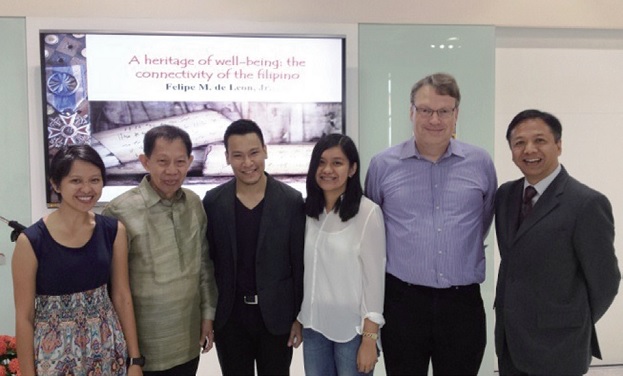
Chairman De Leon with Filipino students from Hong Kong Baptist University (from L to R) Lorie Ann Cascaro, Kristian Agustin and Natasha Dugan, and Professor Mark Thompson of the City University of Hong Kong (in blue shirt) and Director Peter Li of the HKBU International Office (leftmost).
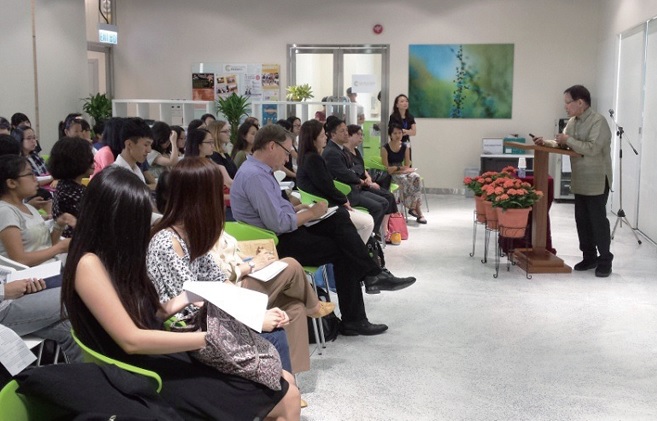
Chairman De Leon during his lecture at HKBU.
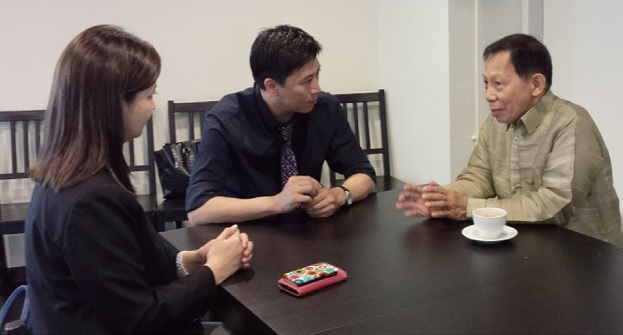
Chairman De Leon with Deputy Consul General Villamor Voogel (left) and Professor Johnny Poon, Head of the HKBU Music Department (center).
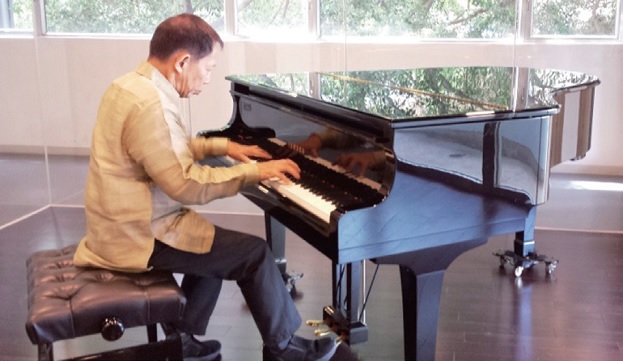
Chairman De Leon during an impromptu piano performance at the HKBU Music Department.

Chairman De Leon with (from L to R) Ms. Raquel Hopton of International Care Ministries, Philippine Red Cross Secretary General Gwendolyn Pang and moderator, Ms. Alexandra Seno, at the Asia Society panel discussion “Road to Recovery: Philippines Ten Months After Haiyan” .
Filipino chefs wow cookery students in Hong Kong
Filipino celebrity chefs Rolando (Chef Lau) and Jacqueline (Chef Jac) Laudico held a Cookery Workshop at the Hong Kong Polytechnic University’s School of Hotel and Tourism Management (SHTM) on 27 October 2014.
SHTM students from different nationalities attended the workshop. Chef Lau taught the students how to prepare Tuna and Scallop Kilawin and the Philippines’ world famous Lechon (roast pig), while Chef Jac did a cooking demonstration of the dessert Suman (Sticky Rice Cake) Panna Cotta.
Students and members of the school’s faculty expressed delight and satisfaction over the sampled dishes prepared by the Laudico couple during the cookery workshop.
The cookery workshop is part of the Philippine Food Festival at The Market of Hotel ICON, which runs from 24 October to 2 November 2014. The festival is co-organized by the Philippine Consulate General and Hotel ICON, and supported by Philippine Airlines and Destileria Limtuaco.
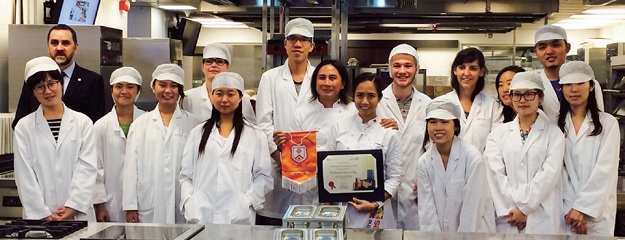
Chef sRolando and Jacqueline Laudico (center, holding plaques) with the students and faculty of the Hong Kong Polytechnic University’s School of Hotel and Tourism Management during the cookery workshop. The workshop coincides with the Philippine Food Festival co-organized by the Philippine Consulate General and Hotel ICON.
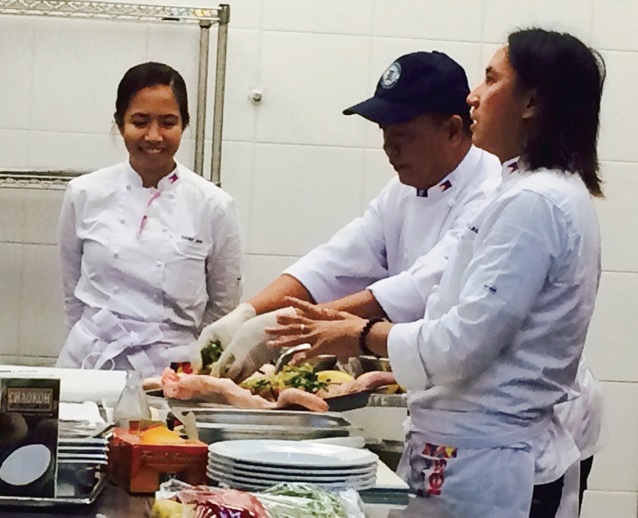
Chef Lau demonstrating how to prepare the lechon or roast pig.
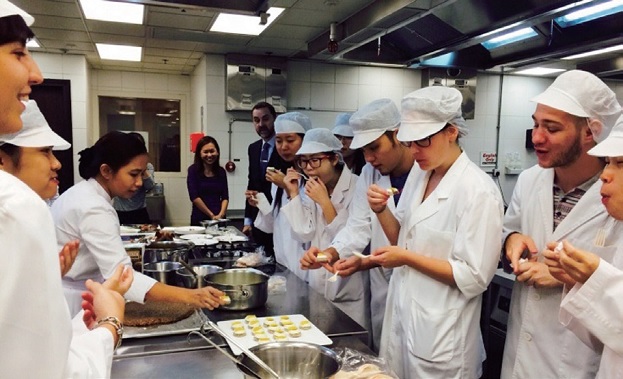
Students enjoy the sampling Chef Jac’s suman panna cotta.
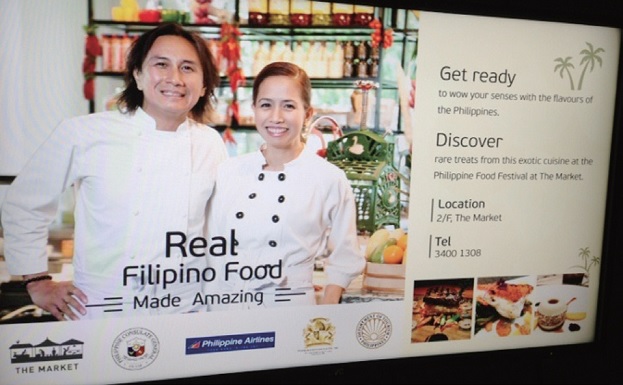
Philippine Food Festival promotion at Hotel ICON.
Hip Hong Kong hotel features Filipino cocktails
Cocktails specially mixed by the Philippines’ oldest liquor company, Destileria Limtuaco, are currently featured at Hotel ICON’s Green café. Known for its cozy and hip interiors, Green is the meet-up place for lunch and afternoon drinks and as a popular bar at night.
The Green’s bar lists Mango Ginger Mojito made from Paradise Mango Rum and Espresso Amadeo with Amadeo Coffee Liqueur as base ingredient, among the drinks being served.
The Filipino cocktails are part of the Philippine food promotion at Hotel ICON’s The Market buffet featuring celebrity chefs Rolando and Jacqueline Laudico. The Philippine Food Festival runs from 24 October to 2 November 2014. It is co-organized by the Philippine Consulate General and Hotel ICON.
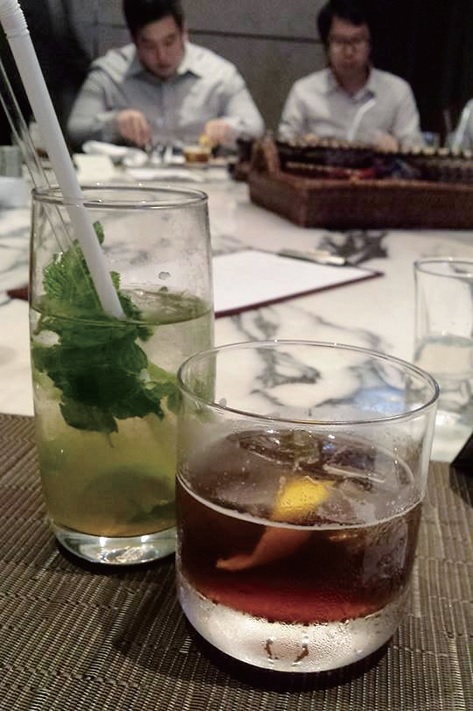
Filipino cocktails featured at Hotel Icon’s Green café: Mango Ginger Mojito (left) and Espresso Amadeo (right).
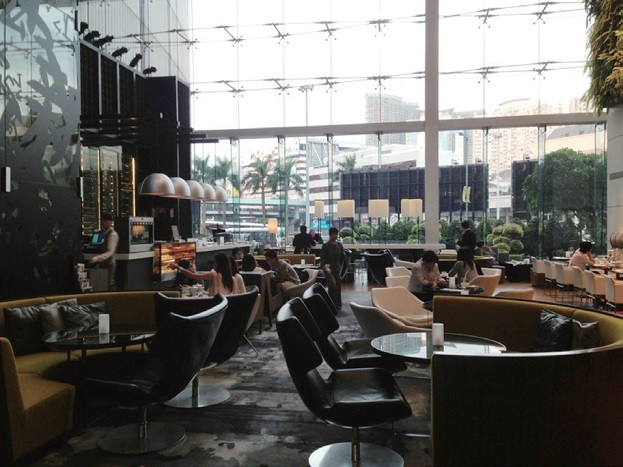
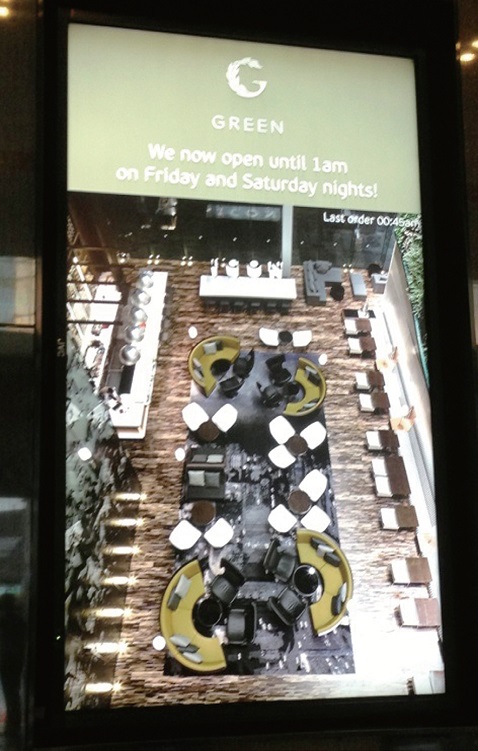
Green café
PCG holds successful PH Food Festival in Hong Kong
The Philippine Consulate General organized the 2014 Philippine Food Festival in Hong Kong SAR. The food fest was launched at The Market of Hotel ICON on 24 October 2014 and ended its successful run on 2 November. This was the hotel’s first-ever Philippine food festival held at The Market which was fully-booked during the entire run. Hotel ICON is a hip luxury hotel in Hong Kong’s Tsim Sha Tsui area.
Filipino celebrity chefs Rolando (Chef Lau) and Jacqueline (Chef Jac) Laudico prepared signature Filipino dishes such as tuna and scallop kilawin, duck adobo, prawn miso sinigang soup, mango salad in bagoong (shrimp paste) vinaigrette, pan-fried lapu-lapu fillet in tabang talangka (crab roe) sauce, bringhe (Philippine version of paella), grilled Angus rib-eye bistek Tagalog and the Philippines’ famous lechon (roast pork). For dessert, Chef Jac served suman (sticky rice cake) panna cotta, tsokolate oh (chocolate mousse), banana and jackfruit turon (fried sweet wrap) and halo-halo.
Mango ginger mojito, espresso Amadeo and Manille martini cocktails from the Philippines’ oldest liquor company, Destileria Limtuaco, were also featured during the event.
Prior to the actual food festival, Hotel ICON held a two-session Food Tasting event on 12 September 2014 for the Hong Kong media which included food writers and bloggers from South China Morning Post, Crave and Foodie magazines, Lifestyle Asia, Apple Daily, Oriental News Daily, Cosmo Girl and Hong Kong’s most popular foodie website www.openrice.com. The Department of Tourism provided souvenir bags during the event.
Philippine Airlines also awarded roundtrip tickets to Boracay for participants in the Food Tasting for the media, and the actual food festival via a food game on the Hotel ICON’s Facebook page.
The Philippine Food Festival is part of the Philippines Consulate General’s cultural diplomacy program which includes promoting Filipino cuisine and food products.
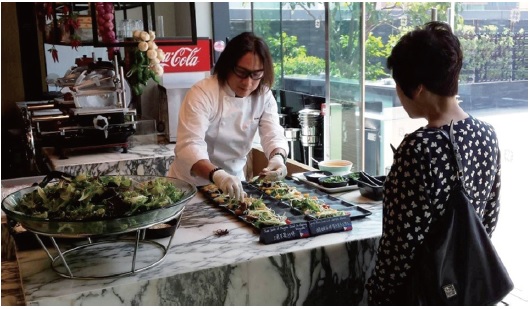
Chef Lau prepares mango salad appetizers at the food festival while a restaurant guest awaits her serving.
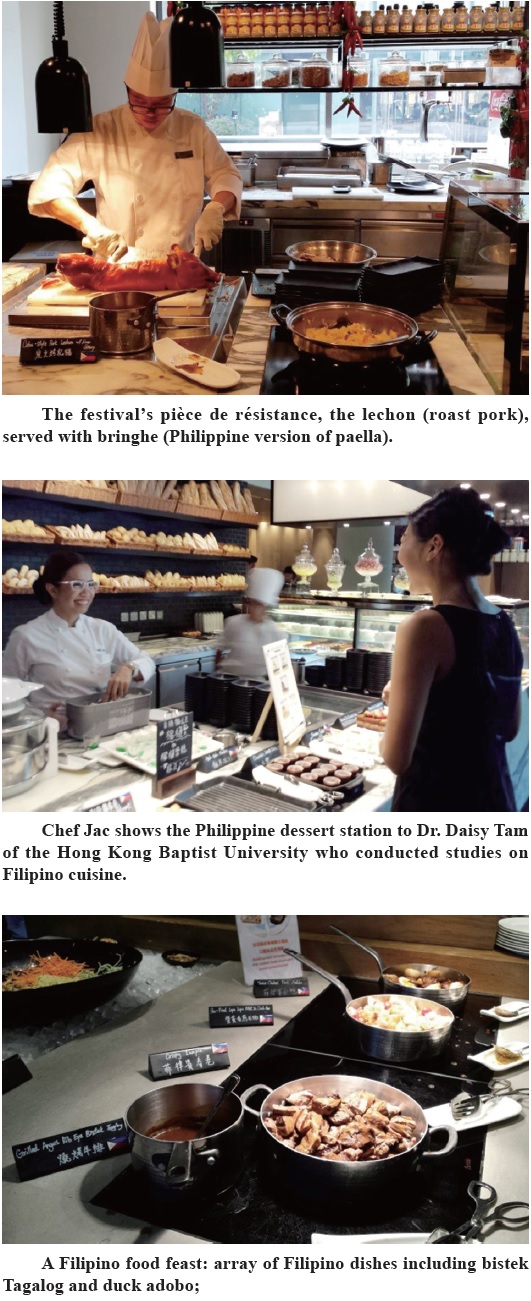
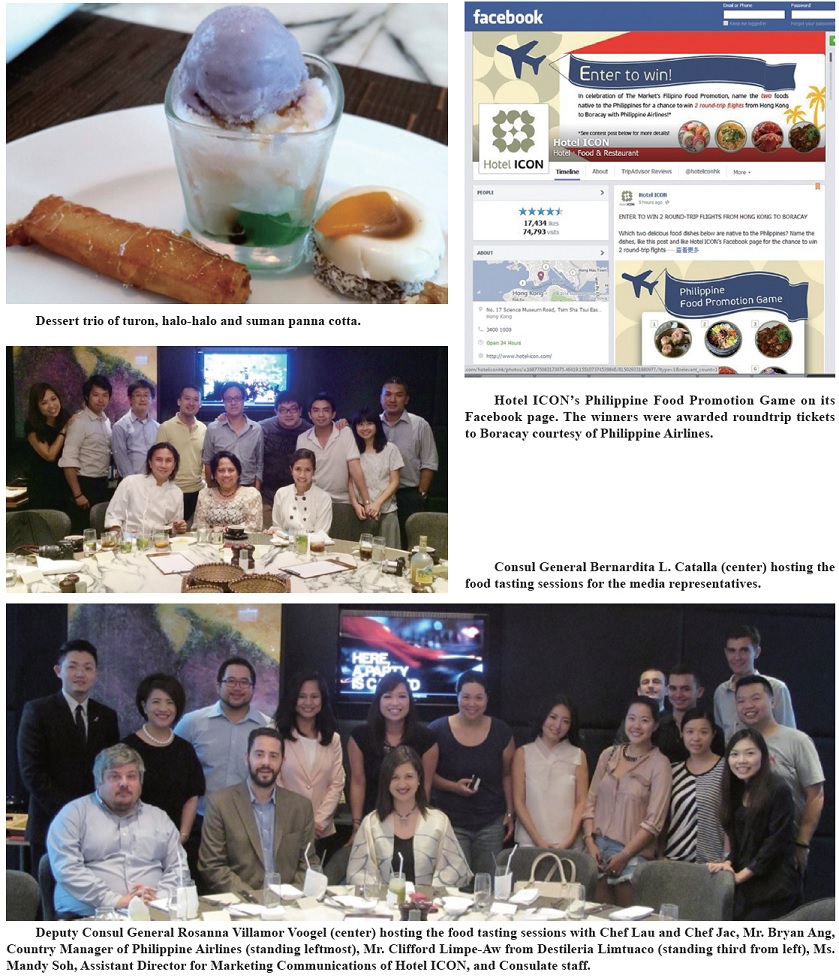
Source: Philippine Consulate General in Hong Kong
